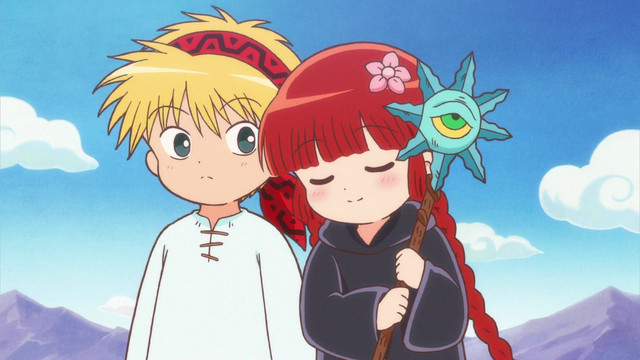
“Nike’s Party Was Wiped Out!”
- Episodes : 24 episodes
- Genre : Adventure, Comedy, Fantasy, Romance
- Airing Date : Jul. 11, 2017 - Dec. 20, 2017
- Producers : Production I.G
Contains Spoilers
Mahoujin Guru Guru (2017) Introduction and Story
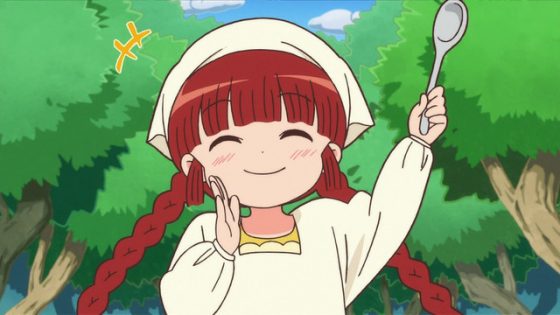
Mahoujin Guru Guru was originally a manga created by Hiroyuki Eto. Prior to the 2017 version, Mahoujin Guru Guru ran in the Monthly Shounen Gangan from 1992 to 2003. It also had two TV adaptations and a manga sequel later.
Mahoujin Guru Guru (2017) is a story with a familiar premise, a demonic entity, Giri, is about to be revived. To stop his revival, a hero must rise and stop demonic forces from taking over the world. Simple, but Mahoujin Guru Guru takes a simple premise and develops it beautifully.
Enter Nike, the unwilling hero candidate, and Kukuri, the last wielder of the legendary magic: Guru Guru. These teenage protagonists fit the same demographic as its viewers/readers, a fitting parallel. Just as the story is an example of the “Hero’s Journey,” it also doubles as a story about adolescent growth.
By combining the aesthetics of retro RPG’s, Mahoujin Guru Guru homages older games, creating a sense of nostalgia and an apt setting for one’s childhood. Pixel graphics on close-ups, 8-bit overworld caricatures, a heavy emphasis on quests, and leveling up are just some examples of the show’s gaming foundation.
With the show’s retro roots, it’s fitting that its comedy also sprouts from there. This is where things begin to shine.
The show’s director, Hiroshi Ikehata, embellishes the visuals. A common technique he uses is supplementing information with appropriate gaming visuals.
What is the next line in the dialogue? A boss character reads a script on how to appear more “villainous,” but appears comedically childish in the process. Why is the broken hair accessory important? Kukuri resolves herself and a game UI pops up, “Kukuri decides to fight!” What is the name of the individual Nike calls out to before leaving on a ship? A name title appears, “Runrun,” which gets quickly slapped down by the nervous individual it's placed upon.
While this technique might not appeal to all audiences, a few details should be mentioned. Hiroshi Ikehata is adapting the entirety of the original manga--that’s 16 volumes of the first Mahoujin Guru Guru! Second, the 2017 version is only 24 episodes, meaning a lot of material is getting condensed. To give context, the 1994 version is 45 episodes and the 2000 version is 38. Lastly, the show’s target demographic is a young audience (age 13 and above).
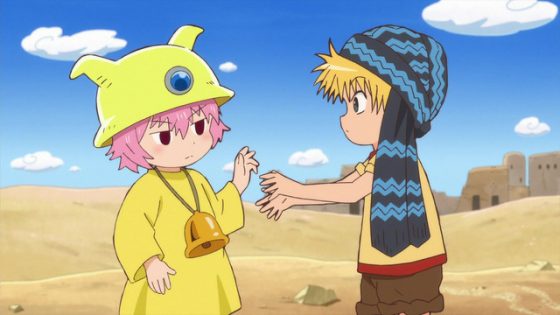
Adapting a large source material requires finesse and each adaptation requires its own answer. A large source of material puts a strain on adapting that information. A limited amount of episodes limits the amount of creative freedom you can employ. Lastly, you need to make the anime appealing. The target demographic is young--their attention span might favor certain visual techniques.
In light of these details, the technique the director employs makes more sense. However, the natural result is the frantic pace of the show. This is where opinions start to divide.
Mahoujin Guru Guru is definitely not a show you can marathon. The amount of information packed into one episode is double-edged. One moment you can look away and three jokes have already been sprung. Another moment, you’ve missed the name of a character or the relevance of where they are going, what they are doing, who is the new party member, and so on.
The positives are there as well. It’s awe-inspiring how much the director has made every minute count. Even the ending credits and after credits are used to introduce more information and jokes--some of which carry over to the next episode. Concerns over too much information are also relaxed if you’re familiar with the archetypal story. The economic use of time highlights how much effort the mangaka put into subverting expectations. The show is the same way. It will constantly surprise you.
The show’s pacing could use variation, and while the jokes do come in all shapes, their appearance rate feels like an unintentional parody of old RPG encounter rates.
However, it’s important to make a distinction when it comes to adaptations. If your complaint about the show is its pacing--an understandable critique--it’s not always the fault of the direction. Limitations exist, but those are things are like prerequisites, not something indicative of a director’s skill.
In the final episodes of Mahoujin Guru Guru, Hiroshi Ikehata starts strong. Proving himself a director of different talents, he directs episode 20 in a majestic fashion. It is easily one of the best episodes of the show.
The quick pace takes a deliberate...
Full. Hard. Stop.

Time has frozen, and as is typical of these RPG-esque stories, the heroes must ascertain their own values: why are they really fighting? The tone of this episode is serious, and the directing techniques are thematically relevant.
Gone are the pre-episode reminders and opening theme. Gone are the cute commercial break visuals--in its place are images of isolation. Gone are the more cutesy lighting and color tone of the show, replaced by a more realistic lighting during the day.
Highlighting the abnormality of this episode, the director starts in media res. Characters are introduced as if they were always there--no naming UI or obvious supplemental visuals. Viewer confusion turns to surprise as the episode unfolds.
There is a trick to this episode, and the visuals are changed accordingly. This typical sequence this calm before the storm, this peace before the ensuing chaos, really is an important period. Body language, camera shots, more subtle directing, a mostly unpronounced style within the show’s quick nature, gets put fully on display.
The episode unfolds wonderfully from these creative liberties. It exemplifies what the show can do when it doesn’t rush information. Pacing truly is a fundamental issue for adaptations, and whether viewers appreciate the show will depend on how they view its quick nature: is it a feature or a constraint?
What We Liked About Magical Circle Guru Guru (2017)
Magical Circle Guru Guru (2017) is a prime example of homage. It caters to a young audience but also appeals to an older audience with the nostalgia of retro RPGs. The story diversifies familiar tropes with its comedy and expands the “Hero’s Journey” for both young boys and girls. While I cannot say the show is always fitting for younger audiences (a rare joke might stray into questionable territory), the general tone, diverse characters, and simple story are appealing for teenage youths.
Discussion Time
The source material is filled with jokes, and as a comedy manga, it helps subvert its familiar roots by reversing typical notions of its setting and characters--it’s fitting since the roots of parody work in a similar way. This story really isn’t just about the “Hero of Light.” It’s equally about the “Heroine of Darkness.” This story isn’t just about conquering evil, it’s about finding love, a notion that is relevant to how Kukuri uses her magic. There’s a definite appeal of the story towards a younger audience, and as an adolescent story, I’m fond of most of the ideas.
Unfortunately, outside of its initial appeal, the quick pace of the show might be a feature or a detriment depending on the viewer. For viewers who favor more variation in pace, the speed and intensity that each episode goes through information might be unappealing. For those who seek surprise after surprise, the number of jokes and unexpected twists will definitely delight you.
Why You Should Watch Magic Circle Guru Guru (2017)
For those who appreciate archetypal stories with twists, I think this show is one to consider. By playing upon your understanding of old RPG's, the show makes a lot of references to the retro video game era. The show also has a broad appeal by touching upon its adventure story mixed with romantic and comedic elements. Lastly, I think it’s worth mentioning how many characters are in this show. While some jokes might be played a bit often--jokes are often attached to certain character habits--the diversity of characters prevents the show from becoming too predictable or stale.
1. You’re a Fan of Retro RPGs
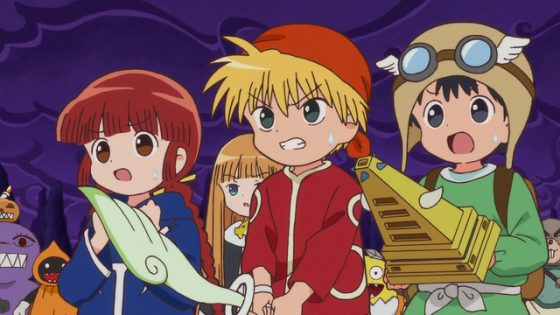
The obvious appeal of the show is how it takes a common setting in retro RPGs and plays upon its themes. The old tried-and-true story of a Hero of Light must save the world from the Demon King is purposefully familiar.
The show has such an assortment of ways its play with its setting. The structure of its episodes alludes to common RPG quests, the characters represent archetypal party members (with comedic quirks), the visual 8-bit sound effects and pixels help sweep you into your child’s favorite gaming moments.
2. A Huge Array of Comedic Surprises

If Magic Circle Guru Guru plays upon your familiarity with tropes and themes. It’s rare to go through the show without seeing a new joke or surprise. The basic premise makes the story easy to follow, allowing a montage of jokes to play out.
If you’re interested in seeing examples of how to twist the familiar into the unfamiliar--a reversal of expectations--then Magic Circle Guru Guru is worth your attention.
3. The Diverse Cast of Characters

The characters are a quirky mix that drives the show’s jokes. The quiet and somber Juju who regularly breaks her holy attire with her battle fanaticism and zeal for religion, the oddly passionate dancing old man who wishes to spread his disastrously frightening dance, the eccentric demon prince whose magic depends upon his strange poses are just a handful of characters that appear in the show.
Different jokes will be attached to this motley cast, and you’ll easily find a favorite character within the world of Magic Circle Guru Guru.
Why You Should Skip Magic Circle Guru Guru
If you’re looking for a show that’s slower in pace or a huge variety of visual techniques, this show is not for you. While the show uses its game premise effectively in visual cues, the necessity of those cues will be repeated constantly throughout the show.
Episodes will be crammed with so much information that a slower style of comedy won’t often be employed. Extending a scene’s comedic timing is a rarity. Instead, the show favors a larger amount of jokes, which can make some jokes really miss its mark.
1. Pacing
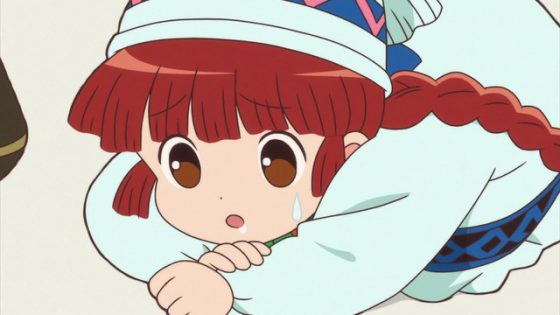
Magic Circle Guru Guru (2017) is 24 episodes and its 1994 version and 2000 version are 45 and 28 episodes respectively. Imagine cramming 16 volumes worth of material in less time, and it’s obvious that the show suffers at times from how much it condenses its source material.
Despite the simple premise, the speed of which the show goes through its content makes it hard to retain what happens in each episode. Looking away for a quick moment can easily make you miss information about the characters, their location, and purpose for their current quest. While this isn’t always important, missing details only to miss what a later scene references hurt the comedic impact and appeal of the show.
2. Low Variance in Comedic Timing
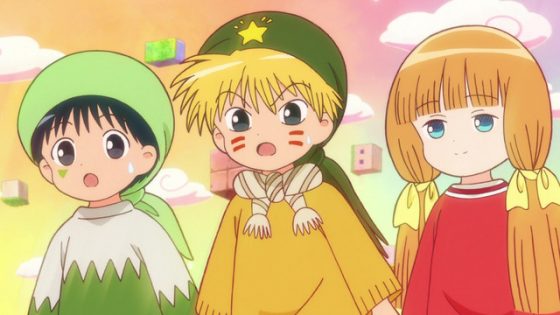
Comedic timing is an important element of comedy. Imagine your favorite joke being told, then immediately springing forth into another joke before your audience takes a breath to laugh. While this is partly the fault of pacing, the huge number of jokes in the show can easily backfire, especially if you’ve grown tired of recurring jokes.
Giving the appropriate time for jokes is more than just for audience retention. It’s a necessity for the delivery and effectiveness of the joke. While the show showers the viewer with such an array of comedy, it could have easily cut out recurring jokes in favor of unique ones.
Final Thoughts
I didn’t expect to find the show as appealing as it was at first, but its appeal towards my RPG nostalgia roped me in. As a fan of the RPG genre, I also appreciated the familiar story. its appealing cast of characters was a delightful surprise, and I easily found my favorites quite quickly.
Magic Circle Guru Guru isn’t the show for everyone, but I still would recommend viewers to give it a shot, especially if they are fans of retro games and comedy.
Recommended Post
Mahoujin Guru Guru 2 - Summer & Fall 2017
Recommended Post


